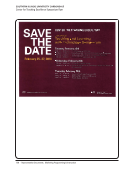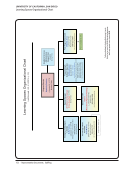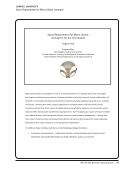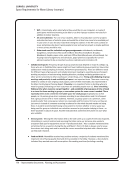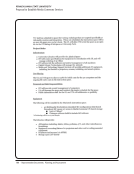52 · Survey Results: Survey Questions and Responses
Research Commons, Scholars’ Studio: juried lightning talks by graduate students presented to live audience, which
provides feedback. Staff responsible: Research Commons librarians and staff from Graduate School.
Several thousand people attend workshops each year at the Information Commons. Topics include video, presentation
software, animation, graphic and web design, and integration of technology into teaching and learning. The staff and
graduate student interns have substantial expertise in new media production and the space also attracts a large number
of guest presenters from faculty, staff, and students (undergraduate and graduate) from around campus.
Students gave presentations and exhibited posters of their research done using GIS in the GIS lab.
The Digital Salon exhibition of student digital media works is held annually in the undergraduate library (and online) and
is supported in partnership with the DesignLab. Student work is projected and run on monitors for a week in the cafe
space in the library, as well as on a monitor throughout the year in the DesignLab space. Some of the work has been
quite experimental and includes art installation. Librarians, library IT professionals, and DesignLab staff work together to
collect submissions, curate, and install exhibition.
The exhibit spaces in the Central Library in addition to having traditional exhibit cases have interactive touch-screen
monitors. The programming on the touch screens are customized to the theme/topic of the cases in the area, providing
further information/details about case contents, or supplementary information both textual, graphic, and video.
There have been instances when patron(s) have spent over an hour in one section of the exhibit, exploring all of the
interactive content.
The Gallery is meant to be a gathering place for the enrichment of the intellectual, educational, and cultural life of
the campus and the larger community. The library aspires to: showcase and interpret the library’s rich collections,
promote their scholarly use, and use collections to facilitate scholarship and storytelling support the library’s role as an
intellectual center of the university foster relationships between the library and faculty, students, alumni, staff, and the
state and local community.
The Health Science Center Library’s open collaboration space hosted a Harry Potter exhibit and opening event with
science demonstrations (magic), costume contest, wand making, and trivia contest.
The high-tech classroom in the Center for Digital Scholarship is used regularly for GIS training and for a credit-bearing
GIS class.
The International &Area Studies Library, which opened in summer 2011, located within the Main Library building, has
offered cultural programs such as musical performances and lectures by foreign dignitaries in its reading room.
The lab with fixed computers and specialized software served as the site for a geographic information systems-focused,
interactive workshop. The GIS librarian planned and led the workshop. Participants collected data using a GPS device
and took it into the lab to clean it, add it, and edit it using an open source and open access mapping system.
The classrooms incorporate media into instruction activities, for example (historic) sound recordings. Librarians and
faculty both use spaces for teaching that actively use these materials.
The Public Services department has invited multiple faculty to participate in research panels in library commons.
The Science &Engineering Library hosted a session wherein a Springer materials sciences representative engaged in a
lively question and answer discussion with Department of Chemical &Materials Sciences faculty and graduate students
on the research applications of Springer’s materials database.
The student club needed a gallery space, so the library included one in its renovation. The space is managed by an
Exhibits Specialist who is also responsible for the other library exhibit spaces. Faculty also use the space to display class
projects and occasionally their own work.
Research Commons, Scholars’ Studio: juried lightning talks by graduate students presented to live audience, which
provides feedback. Staff responsible: Research Commons librarians and staff from Graduate School.
Several thousand people attend workshops each year at the Information Commons. Topics include video, presentation
software, animation, graphic and web design, and integration of technology into teaching and learning. The staff and
graduate student interns have substantial expertise in new media production and the space also attracts a large number
of guest presenters from faculty, staff, and students (undergraduate and graduate) from around campus.
Students gave presentations and exhibited posters of their research done using GIS in the GIS lab.
The Digital Salon exhibition of student digital media works is held annually in the undergraduate library (and online) and
is supported in partnership with the DesignLab. Student work is projected and run on monitors for a week in the cafe
space in the library, as well as on a monitor throughout the year in the DesignLab space. Some of the work has been
quite experimental and includes art installation. Librarians, library IT professionals, and DesignLab staff work together to
collect submissions, curate, and install exhibition.
The exhibit spaces in the Central Library in addition to having traditional exhibit cases have interactive touch-screen
monitors. The programming on the touch screens are customized to the theme/topic of the cases in the area, providing
further information/details about case contents, or supplementary information both textual, graphic, and video.
There have been instances when patron(s) have spent over an hour in one section of the exhibit, exploring all of the
interactive content.
The Gallery is meant to be a gathering place for the enrichment of the intellectual, educational, and cultural life of
the campus and the larger community. The library aspires to: showcase and interpret the library’s rich collections,
promote their scholarly use, and use collections to facilitate scholarship and storytelling support the library’s role as an
intellectual center of the university foster relationships between the library and faculty, students, alumni, staff, and the
state and local community.
The Health Science Center Library’s open collaboration space hosted a Harry Potter exhibit and opening event with
science demonstrations (magic), costume contest, wand making, and trivia contest.
The high-tech classroom in the Center for Digital Scholarship is used regularly for GIS training and for a credit-bearing
GIS class.
The International &Area Studies Library, which opened in summer 2011, located within the Main Library building, has
offered cultural programs such as musical performances and lectures by foreign dignitaries in its reading room.
The lab with fixed computers and specialized software served as the site for a geographic information systems-focused,
interactive workshop. The GIS librarian planned and led the workshop. Participants collected data using a GPS device
and took it into the lab to clean it, add it, and edit it using an open source and open access mapping system.
The classrooms incorporate media into instruction activities, for example (historic) sound recordings. Librarians and
faculty both use spaces for teaching that actively use these materials.
The Public Services department has invited multiple faculty to participate in research panels in library commons.
The Science &Engineering Library hosted a session wherein a Springer materials sciences representative engaged in a
lively question and answer discussion with Department of Chemical &Materials Sciences faculty and graduate students
on the research applications of Springer’s materials database.
The student club needed a gallery space, so the library included one in its renovation. The space is managed by an
Exhibits Specialist who is also responsible for the other library exhibit spaces. Faculty also use the space to display class
projects and occasionally their own work.










































































































































